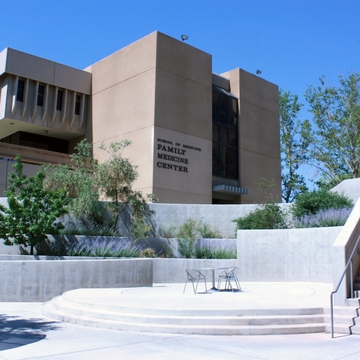New Tool Helps ER Doctors Decide When to Order a CT Scan for Suspected Cervical Spine Injury

All in the family
UNM School of Medicine graduates lead U.S. in family medicine residencies
A higher percentage of graduates from the University of New Mexico School of Medicine enter family medicine residencies than any other MD degree-granting institution in the nation, a new study has found.
The study, published in the October issue of the journal Family Medicine, found that over a three-year period, 20.7 percent of UNM graduates chose family medicine as their career path, on average. East Carolina University followed, with 19.6 percent, and the University of Minnesota was third, with 18.9 percent.
"We're very proud of these findings, especially in light of the national crisis in graduating a sufficient number of primary care doctors," said Paul B. Roth, MD, MS, the School of Medicine's dean and UNM's Chancellor for Health Sciences.
UNM's family and rural medicine programs are regularly ranked among the best in the country by U.S. News & World Report. Graduating medical students spend another three years or more in residency before they go out to practice on their own.
Martha Cole McGrew, MD, the medical school's executive vice dean, said the findings underscore the School of Medicine's commitment to serve New Mexicans by developing the primary care workforce, especially in rural and underserved areas.
"We have a long history of community-based medical education, and this is the result," McGrew said. "It's a tribute to family physicians and communities around the state who have been welcoming our students since our medical school began more than 50 years ago."
Physicians often decide where they want to practice based on where they complete their residency after medical school, McGrew added. "We want even more students who choose family medicine to stay here for residency training and to practice medicine after residency."
Arthur Kaufman, MD, UNM's vice chancellor for community health, credits an admissions policy that selects students predisposed to a career in family medicine.
"Ninety-five percent of our students are from New Mexico, and many are from rural and ethnically diverse backgrounds," Kaufman said. UNM's Combined BA/MD Program, which recruits promising high school students from around the state into an educational pipeline leading to medical school, has also played a key role, he added.
The results come from the 36th national study conducted by the American Academy of Family Physicians. The authors ranked the top 20 allopathic (MD degree-granting) and top 20 osteopathic (DO degree-granting) medical schools for graduating family medicine residents.
Osteopathic physicians typically practice family medicine in higher numbers. Fully 28 percent of graduates from the Des Moines University College of Osteopathic Medicine chose family medicine residencies, the study found.
Overall, the study found most American medical schools were failing in their mission of graduating enough primary care providers to meet current and future needs. Primary care doctors represent about 35 percent of the physician workforce, and the rate appears to be declining.
"Building the physician workforce to achieve optimal health for the United States will require having the optimal numbers and specialty mix of physicians, diverse to match the populations being served, and practicing in the right geographic locations," the study concluded.